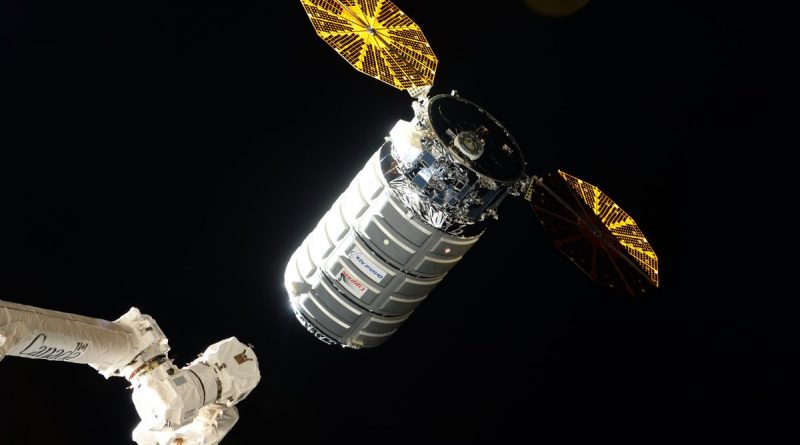Cygnus Cargo Ship Captured by Space Station for Three-Month Stay & Critical Science Delivery
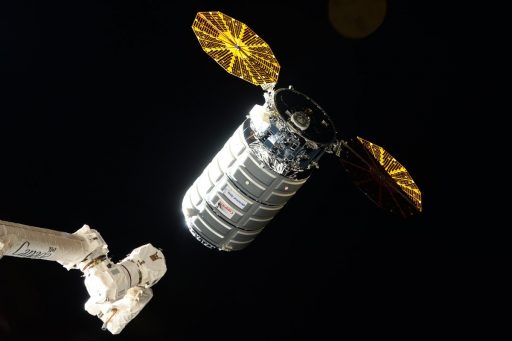
Booked for a three month stay, Orbital ATK’s Cygnus OA-7 cargo spacecraft arrived at the International Space Station on Saturday, hauling nearly 3,500 Kilograms of supplies to the orbiting laboratory to support dozens of scientific experiments, ISS maintenance, and an unprecedented CubeSat constellation for the exploration of a largely unknown region of Earth’s atmosphere.
The Cygnus spacecraft, christened the S.S. John Glenn to honor the late U.S. Senator & member of NASA’s Mercury Seven, arrived at the Space Station after a four-day free flight following liftoff from Cape Canaveral atop an Atlas V on Tuesday. Approaching ISS from straight below, Cygnus arrived within reach of the Station’s Canadarm2 for a robotic capture at 10:05 UTC, followed by berthing to the Unity module later on Saturday to open the spacecraft for business.
Saturday’s robotic capture came just one day after Canadarm2’s 16th birthday – it arrived at the Space Station on April 21, 2001 aboard Space Shuttle Endeavour and became an essential part in the construction of the orbiting complex and remains in a critical role to this day, supporting spacewalks, moving external components, and grabbing arriving cargo spacecraft. The S.S. John Glenn was the 23rd spacecraft captured by Canadarm2.
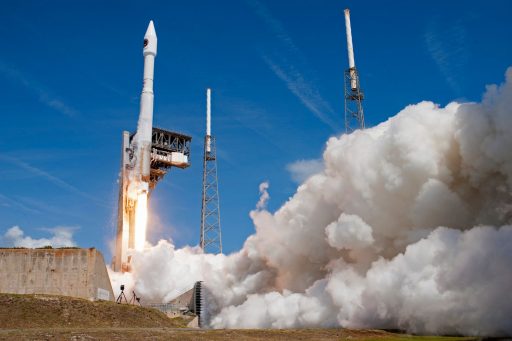
Orbital ATK’s seventh operational ISS cargo mission under NASA’s Commercial Resupply Services Program began at 15:11 UTC on Tuesday when the 7,221-Kilogram spacecraft took flight atop its Atlas V rocket. Checking off its 71st mission, Atlas V released the spacecraft into an orbit of 230 Kilometers 21 minutes after blasting off from Florida.
Cygnus had to take the scenic route to ISS, raising its orbit on Tuesday and Wednesday to enter an orbital parking slot around 2,500 Kilometers behind ISS to stay clear of the Soyuz MS-04 spacecraft that lifted off from Kazakhstan on Thursday and linked up with ISS in just six hours to deliver veteran Cosmonaut Fyodor Yurchikhin and NASA Astronaut Jack Fischer to the Space Station.
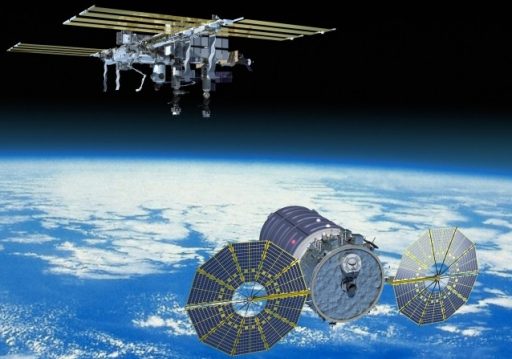
The spacecraft maneuvered into an orbit ten Kilometers below ISS after Soyuz arrived so that it would slowly catch up with ISS from behind and below, setting up for Saturday’s rendezvous. Beginning the day’s operation, Cygnus was in an orbit four Kilometers below that of ISS when it entered the 28-Kilometer communications zone around the Station that enabled the two craft to exchange GPS information to mark the start of the relative navigation phase of the rendezvous.
Orbital ATK’s Mission Control Center in Dulles, Virginia entered integrated operations with Mission Control Houston around 7 UTC with MCC-H holding the overall authority over the activity while MCC-Dulles provided updates on Cygnus status and commanded the spacecraft. A pair of Approach Delta-Velocity burns (ADVs) transitioned Cygnus into an orbit 1.4 Kilometers below that of ISS, still catching up from behind.
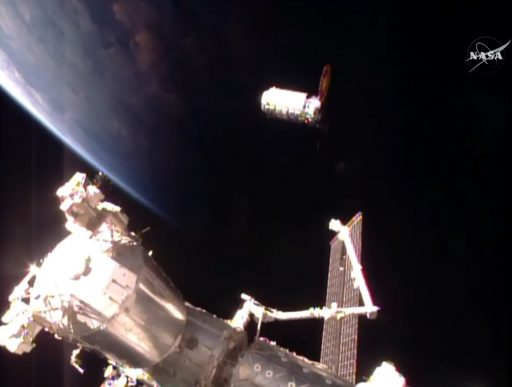
Aboard the International Space Station, the crew readied for the spacecraft’s arrival by setting up shop inside the Cupola. Frenchman Thomas Pesquet manned the robotics workstation on Saturday while Peggy Whitson handled communications with Mission Control and commanded the Cygnus through the Hardware Command Panel. Jack Fischer – the newest addition to the U.S. Segment Crew – was in a monitoring position, allowing him to gather first hand experience for when he will be one of the active crew members for the next Dragon arrival.
The ADV-3 burn marked the Approach Initiation Maneuver, putting Cygnus on a course to a point directly below the Station for a straight-up approach on what is known as the R-Bar – the imaginary line connecting ISS and the center of the Earth. Cygnus acquired the R-Bar at a range of around 350 meters and activated its TRIDAR laser-based navigation system to capture 3D data of ISS that was then put through navigation software to calculate the precise geometry between Cygnus and its target.
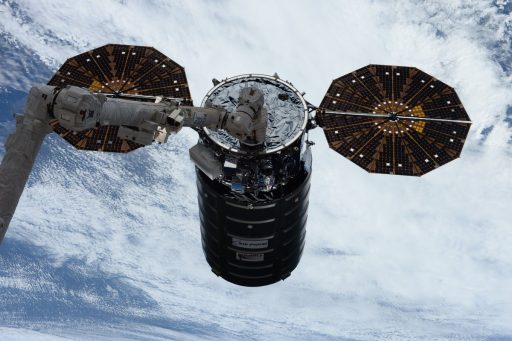
ADV-4 marked the start of the R-Bar approach and Cygnus came to a pre-planned stop at 250 meters, the first of two pauses in the proximity operation providing time for teams at Mission Control to verify the performance of the navigation system and check the craft’s position within the pyramidal approach corridor.
Gently firing its thrusters, Cygnus advanced from 250 meters in the dark of night, entering what is known as the Keep-Out Sphere where the highest safety standards have to be met by visiting vehicles. The hold at 30 meters was timed to have Cygnus arrive at the capture point once lighting conditions were suitable, taking 15 minutes to cover the final 20 meters to the capture point.
Arriving within reach of the station’s 18-meter long robotic arm, Cygnus came to a stop and reduced all relative rates between itself and ISS to be as still as possible for the upcoming capture while ISS entered a fine attitude hold to also be as stable as possible.
Thomas Pesquet released the brakes from Canadarm2 and lined up the arm’s Latching End Effector with the Power and Video Grapple Fixture on the aft end of Cygnus. With Cygnus in free drift, Pesquet moved the end effector over the grapple pin to allow snares to close and obtain a firm grip of the spacecraft.
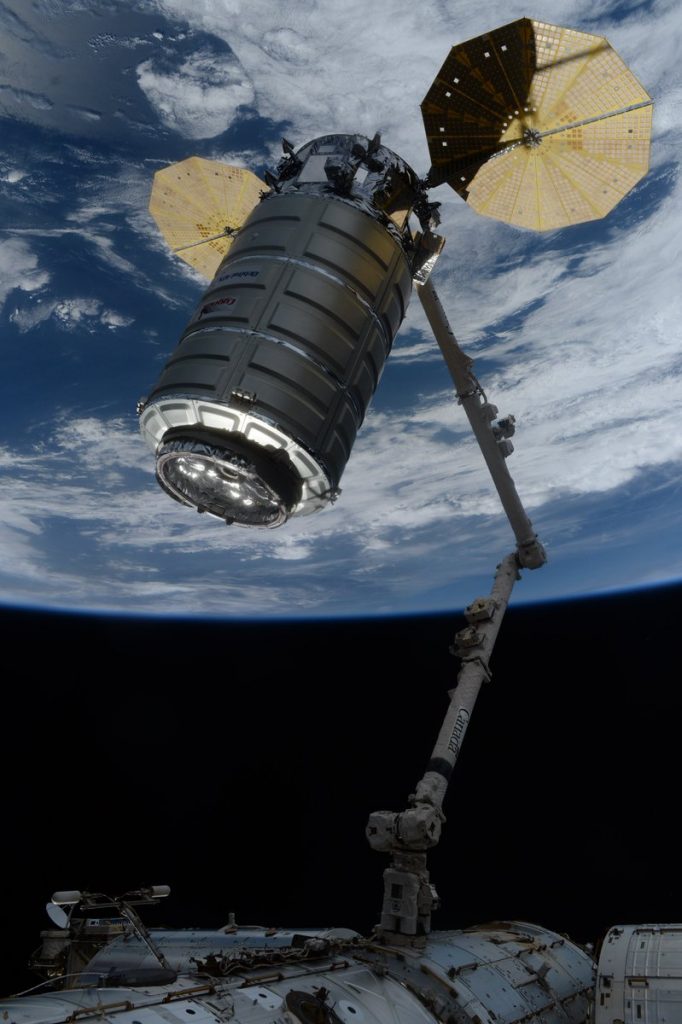
Capture was confirmed at 10:05 UTC while the Space Station was passing over Germany – three days, 18 hours and 54 minutes after launch.
After a smooth rendezvous and capture, Cygnus underwent a series of safing steps and the ISS crew handed robotics over to the ground team that was in charge of the multi-hour berthing activity. To bring Cygnus in for attachment to ISS, ROBO controllers put the arm through a series of pre-programmed maneuvers to swing the spacecraft around to Node 1, first to a stand-off position to permit a survey of the Common Berthing Mechanism of the spacecraft.
Cygnus was positioned with millimeter-accuracy using the Centerline Berthing Camera System to obtain four green Ready-to-Latch indicators which signaled readiness for capture. Four capture latches closed and accomplished what is known as first stage capture, allowing the SSRMS to be switched to limp mode, giving Cygnus some wiggle room to be pulled in by the bolts within the berthing mechanism. Four gangs of four bolts were driven to mark Stage 2 capture and berthing for the Cygnus OA-7 spacecraft at 12:39 UTC.
With Cygnus officially part of ISS, teams at Mission Control headed into the hour-long task of loading each CBM Bolt with a specific torque before providing the crew with the GO to press into leak checks. After opening the hatch of the Unity module, the three USOS crew members will perform the standard vestibule outfitting by removing covers and four Control Panel Assemblies used to drive the CBM bolts, and putting in place data and power jumpers to integrate Cygnus with ISS Systems.
When opening the hatch to Cygnus, the crew will be greeted by a large poster of John Glenn whose name this mission carries as Orbital ATK has a tradition of naming their cargo vehicles after NASA Astronauts. Entering the spacecraft, the crew is tasked with an initial inspection wearing protective gear to ensure no floating debris can harm them. Ventilation systems will be set up before Cygnus can be declared open for business, marking the start of several weeks of cargo transfers.
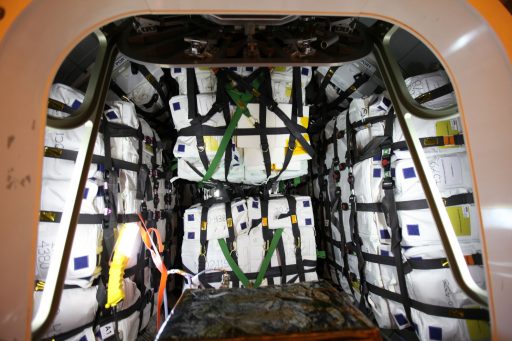
Cygnus OA-7 is carrying more science and utilization cargo to the Space Station than any U.S. Commercial Resupply Services vehicle to date, supporting a busy summer of science operations with 216 studies planned across the U.S. Segment during Expeditions 51 and 52, covering virtually all branches of science.
Packed into the Cygnus cargo craft is a total pressurized cargo of 3,376 Kilograms divided in 940kg of science investigations, 954kg of crew supplies, 1,215kg of systems hardware and 93kg of spacewalk equipment, computer resources and Russian hardware.
Items stashed away in the Italian-built pressurized cargo compartment range from supplies such as food for the crew and sanitary items to complex systems hardware like NASA’s Advanced Plant Habitat and a new low-cost device enabling heat shield materials to be tested in the actual environment of re-entry.

